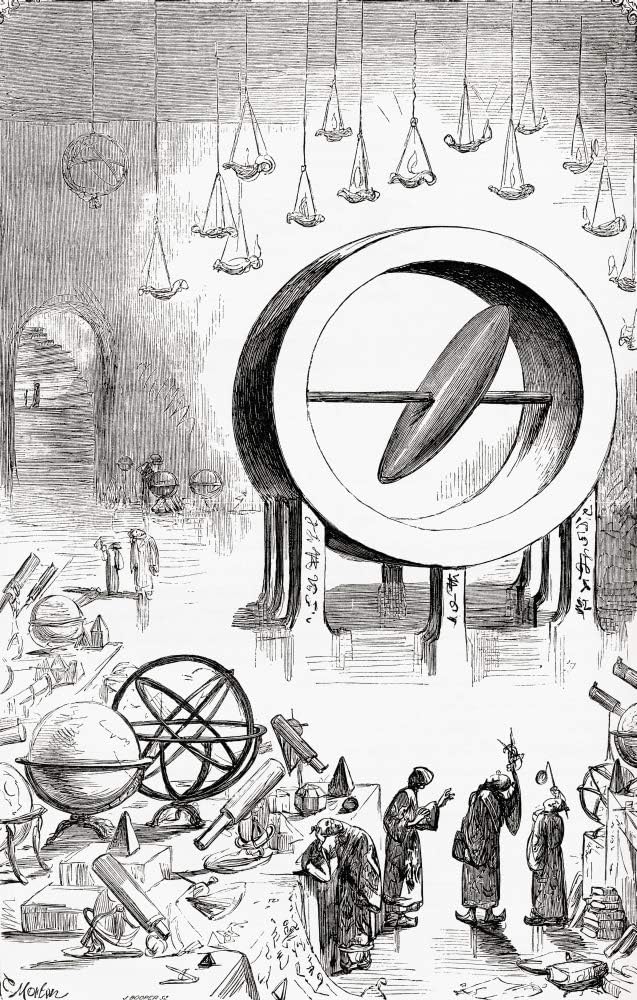My short story, “The Waves on Mars are Really High,” drew inspiration from Jonathan Swift’s “Gulliver’s Travells, published in 1726, and his Voyage to Laputa; an island floating in the sky, propelled by the mythical material adamant.
The attraction was his great attention to detail on how the astronomers of Laputa navigated their island, their obsession with their impending doom from a comet, and the lengths to which he went to portray the voyage as a real event.
Here are some examples.
The Voyage to Laputa

- Gulliver, who was Ship’s Surgeon on the voyage claimed to be the cousin of William Dampier, a famous pirate and explorer in the 17th century who circumvented the world three times and produced books on his explorations.
- He gives precise information on the location of Laputa. Recording it was located east of Japan, south of the Aleutian Islands, and some five days’ journey south-south-east of Gulliver’s last known position, 46° N, 183° E. ….. which I must admit had me reaching for a map to try and find it,
- He said that the astronomers of Laputa had discovered Mars had 2 moons, 150 years before they were discovered.
- He goes into great detail on how the floating island was powered using the supposedly mythical, magnetic material, adamant.
- And the astronomers of Laputa were obsessed with a comet destroying their world and spent much of their time, plotting the paths and orbits of comets.
Let’s look at some details.
The Floating Island of Laputa

In Gulliver’s Voyage to Laputa, Swift gives a precise description the floating island and the means by which the island floats and navigated.
He says the island was 7837 yards in diameter and 300 yards thick, and rested on a plate of adamant, 200 yds thick.
At the centre of the island there was a hole, about 50 yards in diameter, where the island’s astronomers descend into a large dome situated about 100 yards beneath the upper surface of the plate of adamant.
Navigating the floating island

Within the dome was a massive magnetic lodestone, in the shape of a weaver’s shuttle. It was 6 yards long and in the thickest part, 3 yards wide.
This lodestone was held by a very strong axle of adamant passing through its middle, around which it moved.
It was so well balanced that the lightest touch would turn it.
It was contained within a hollow cylinder of adamant, four feet deep, as many thick, and twelve yards in diameter, placed horizontally, and supported by eight adamantine feet, each six yards high.
In the middle of the concave side, there was a groove twelve inches deep, in which the extremities of the axle are lodged, and turned round as there is occasion.
Because the cylinder and its feet were one continued piece with that body of adamant which constitutes the bottom of the island, the stone could not be removed by any force,
By changing the direction of the loadstone, the island was made to rise and fall, and move from one place to another.
Swift’s Moons of Mars
As said above, Swift recorded that the astronomers, who lived on the floating island of Laputa, had observed that Mars had two moons.
This was surprising as the moons of Mars were not discovered until 1874 by Asaph Hall, almost 150 years after Swift wrote his book,
Swift named the moons, Phobos (fear) and the other Deimos (horror). And after the moons were discovered in 1874 , they were named Phobos and Demos in Swift’s honour.
Swift also records that Laputa’s astronomers had calculated that the orbiting distances of the two moons were 3 and 5 Martian diameters with periods of 10 and 21.5 hours.
Their actual orbital distances are approximately 1.4 and 3.5 Martian diameters, and their respective orbital periods are 7.66 and 30.35 hours.
Not very close to Swift’s values, but sufficiently close to generate lots of speculation that Martians came to Earth in the 18th century and visited Swift.
An excellent article on Swift and the moons by Lamont in 1925 can be found here.
Adamant
Adamant is thought to be an archaic name for diamond.
It appeared in literature as an extremely stromg and durable material which could not be broken. E,g,
In Dante’s Divine Comedy completed 1320, the angel at purgatory’s gate sits on adamant.
And In Spencer’sThe Faerie Queene, published 1590, Sir Artegal’s sword is made of Adamant.
In the Middle Ages adamant also became confused with the magnetic rock lodestone, though the reasons are not clear.
see Wiki on an explanation.
I use adamant’s magical magnetic prpoerties, extensively in my book, The Time Palace of Mars, where it is harnessed to great effect to power the chariots of the alien gods.
Swift’s Satire of Experimental Philosophy
So why did Swift go to such lengths to describe Laputa and the floating island?
The New Science
In the 17th century, Western Europe gradually emerged from the slumber of faith, belief, and the Aristotelian concept of proof.
The shift involved a transition towards comprehending the world through proof based on experimental observation.
Influenced by the “new science” advocated by Francis Bacon, pioneers like Boyle, Hook, Wren, and Newton spearheaded this transformative philosophy in the Royal Society.
The Royal Society
The Royal Society was founded in 1628 for the Improvement of Natural Knowledge,
The society’s common theme was to acquire knowledge through experimental investigation.
NOTE: Not enough attention has been paid to how civilisation moved from a world of belief, faith and religion to experimental analysis to arrive at truth, But an excellent history of this transition can be read in Francis Yates’, The Rosicrucian Enlightenment.
The new science became very popular. And people swallowed whatever they read with the same gusto as they had swallowed religion.
Swift saw an opportunity to point this out.
He did this by satirising the Royal Society in “Gulliver’s Travels,” to show the Society’s overemphasis on experimental natural philosophy and its sometimes absurd preoccupation with measurements and experiments.
And used satire as a tool to mock the perceived excesses and shortcomings of the Royal Society’s approach to understanding the natural world during his time.
The idea for a story
Thanks to his satire, Swift gave me enough detail to come up with an idea based on the Voyage to Laputa.
I devised a story whereby the floating islands were on Mars, high above the ancient sea. And were used by the Martians, in the early days of the planet, to defend themselves against comets and asteroids which were bombarding the planet.
The Plot
In my story, after an excellent lunch at a local pub, the reluctant time travellers, James and Elizabeth, are attracted by delicious cakes displayed in the window of a patisserie next door.
However, on enter the shop, they find themselves trapped by an ancient time traveller who suggests that the only escape is for them to enter a time ship at the back of the store.
Seeing no other option, they enter the time ship and are transported to Mars in the distant past at a time when most of the northern pole was covered in sea and before the Tharsis volcanos emerged.
After meeting the time traveller again on another ship, which appears, mysteriously on the Martin sea, they find themselves battling meteors on a strange floating island powered by a machine made of adamant.
James and Elizabeth eventually master the controls of the machine and are able to stop the meteor attack.
But not before Mars is irreparably damaged and the sea, through fissures in the surface, drains underground.
The Waves on Mars are Really High can be found in my anthology, The Webs of Time, available on KIndle and paperback

